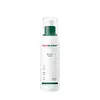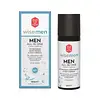What's inside
What's inside
 Key Ingredients
Key Ingredients

 Benefits
Benefits

 Concerns
Concerns

 Ingredients Side-by-side
Ingredients Side-by-side

Water
Skin ConditioningPropanediol
SolventButylene Glycol Dicaprylate/Dicaprate
EmollientMethylpropanediol
SolventTriethylhexanoin
MaskingNiacinamide
SmoothingArachidyl Alcohol
EmollientPanthenol
Skin ConditioningVinyldimethicone
Behenyl Alcohol
Emollient1,2-Hexanediol
Skin ConditioningGlyceryl Stearate Se
EmulsifyingPotassium Cetyl Phosphate
EmulsifyingPolyglyceryl-2 Stearate
EmulsifyingArachidyl Glucoside
EmulsifyingGlyceryl Glucoside
HumectantPolyacrylate Crosspolymer-6
Emulsion StabilisingAmmonium Acryloyldimethyltaurate/Vp Copolymer
Caprylyl Glycol
EmollientCetearyl Olivate
Cetearyl Alcohol
EmollientGlyceryl Stearate
EmollientStearyl Alcohol
EmollientSorbitan Olivate
EmulsifyingHydrogenated Lecithin
EmulsifyingGlycerin
HumectantTocopherol
AntioxidantEthylhexylglycerin
Skin ConditioningFructan
Skin ConditioningCeramide NP
Skin ConditioningAdenosine
Skin ConditioningGluconolactone
Skin ConditioningDisodium EDTA
Glucose
HumectantPolyglyceryl-3 Distearate
EmulsifyingCholesterol
EmollientCentella Asiatica Extract
CleansingPalmitic Acid
EmollientGlyceryl Stearate Citrate
EmollientDipeptide-2
Skin ConditioningMadecassoside
AntioxidantMadecassic Acid
Skin ConditioningAsiaticoside
AntioxidantAsiatic Acid
Skin ConditioningBenzyl Glycol
SolventHydrolyzed Glycosaminoglycans
HumectantStearic Acid
CleansingMyristic Acid
CleansingSodium Hyaluronate
HumectantSodium Hyaluronate Crosspolymer
HumectantHydrolyzed Hyaluronic Acid
HumectantHydroxypropyltrimonium Hyaluronate
Hyaluronic Acid
HumectantSodium Acetylated Hyaluronate
HumectantWater, Propanediol, Butylene Glycol Dicaprylate/Dicaprate, Methylpropanediol, Triethylhexanoin, Niacinamide, Arachidyl Alcohol, Panthenol, Vinyldimethicone, Behenyl Alcohol, 1,2-Hexanediol, Glyceryl Stearate Se, Potassium Cetyl Phosphate, Polyglyceryl-2 Stearate, Arachidyl Glucoside, Glyceryl Glucoside, Polyacrylate Crosspolymer-6, Ammonium Acryloyldimethyltaurate/Vp Copolymer, Caprylyl Glycol, Cetearyl Olivate, Cetearyl Alcohol, Glyceryl Stearate, Stearyl Alcohol, Sorbitan Olivate, Hydrogenated Lecithin, Glycerin, Tocopherol, Ethylhexylglycerin, Fructan, Ceramide NP, Adenosine, Gluconolactone, Disodium EDTA, Glucose, Polyglyceryl-3 Distearate, Cholesterol, Centella Asiatica Extract, Palmitic Acid, Glyceryl Stearate Citrate, Dipeptide-2, Madecassoside, Madecassic Acid, Asiaticoside, Asiatic Acid, Benzyl Glycol, Hydrolyzed Glycosaminoglycans, Stearic Acid, Myristic Acid, Sodium Hyaluronate, Sodium Hyaluronate Crosspolymer, Hydrolyzed Hyaluronic Acid, Hydroxypropyltrimonium Hyaluronate, Hyaluronic Acid, Sodium Acetylated Hyaluronate
Water
Skin ConditioningCyclopentasiloxane
EmollientGlycerin
HumectantDistarch Phosphate
AbsorbentArachidyl Alcohol
EmollientCaprylyl Methicone
Skin ConditioningEthylhexyl Methoxycinnamate
UV AbsorberPanthenol
Skin ConditioningOlus Oil
EmollientPrunus Amygdalus Dulcis Oil
Skin ConditioningTocopherol
AntioxidantHamamelis Virginiana Leaf Extract
Skin ConditioningPunica Granatum Fruit Extract
AntioxidantHelianthus Annuus Seed Oil
EmollientAloe Barbadensis Leaf Juice Powder
Skin ConditioningAllantoin
Skin ConditioningTaurine
BufferingSodium Hyaluronate
HumectantAcanthopanax Senticosus Root Extract
Skin ConditioningChlorella Vulgaris/Lupinus Albus Protein Ferment
Skin ConditioningSoluble Collagen
HumectantHydroxyethyl Acrylate/Sodium Acryloyldimethyl Taurate Copolymer
Emulsion StabilisingBehenyl Alcohol
EmollientParfum
MaskingCoco-Caprylate/Caprate
EmollientArachidyl Glucoside
EmulsifyingDiethylamino Hydroxybenzoyl Hexyl Benzoate
UV FilterGlyceryl Stearate
EmollientXanthan Gum
EmulsifyingPEG-100 Stearate
Potassium Sorbate
PreservativeTetrasodium Glutamate Diacetate
Pentylene Glycol
Skin ConditioningPhenoxyethanol
PreservativeSodium Benzoate
MaskingHexyl Cinnamal
PerfumingLinalool
PerfumingLimonene
PerfumingCitral
PerfumingWater, Cyclopentasiloxane, Glycerin, Distarch Phosphate, Arachidyl Alcohol, Caprylyl Methicone, Ethylhexyl Methoxycinnamate, Panthenol, Olus Oil, Prunus Amygdalus Dulcis Oil, Tocopherol, Hamamelis Virginiana Leaf Extract, Punica Granatum Fruit Extract, Helianthus Annuus Seed Oil, Aloe Barbadensis Leaf Juice Powder, Allantoin, Taurine, Sodium Hyaluronate, Acanthopanax Senticosus Root Extract, Chlorella Vulgaris/Lupinus Albus Protein Ferment, Soluble Collagen, Hydroxyethyl Acrylate/Sodium Acryloyldimethyl Taurate Copolymer, Behenyl Alcohol, Parfum, Coco-Caprylate/Caprate, Arachidyl Glucoside, Diethylamino Hydroxybenzoyl Hexyl Benzoate, Glyceryl Stearate, Xanthan Gum, PEG-100 Stearate, Potassium Sorbate, Tetrasodium Glutamate Diacetate, Pentylene Glycol, Phenoxyethanol, Sodium Benzoate, Hexyl Cinnamal, Linalool, Limonene, Citral
Ingredients Explained
These ingredients are found in both products.
Ingredients higher up in an ingredient list are typically present in a larger amount.
Arachidyl Alcohol is a fatty alcohol made from peanut oil. It is an emollient, emulsifier, and thickener.
You'll most likely find this ingredient as an emulsifier in water-based cosmetics.
We don't have a description for Arachidyl Glucoside yet.
Behenyl Alcohol is a type of fatty alcohol (these are different from the drying, solvent alcohols).
Fatty Alcohols have hydrating properties and are most often used as an emollient or to thicken a product. They are usually derived from natural fats and oils; behenyl alcohol is derived from the fats of vegetable oils.
Emollients help keep your skin soft and hydrated by creating a film that traps moisture in.
In 2000, Behenyl Alcohol was approved by the US as medicine to reduce the duration of cold sores.
Learn more about Behenyl AlcoholGlycerin is already naturally found in your skin. It helps moisturize and protect your skin.
A study from 2016 found glycerin to be more effective as a humectant than AHAs and hyaluronic acid.
As a humectant, it helps the skin stay hydrated by pulling moisture to your skin. The low molecular weight of glycerin allows it to pull moisture into the deeper layers of your skin.
Hydrated skin improves your skin barrier; Your skin barrier helps protect against irritants and bacteria.
Glycerin has also been found to have antimicrobial and antiviral properties. Due to these properties, glycerin is often used in wound and burn treatments.
In cosmetics, glycerin is usually derived from plants such as soybean or palm. However, it can also be sourced from animals, such as tallow or animal fat.
This ingredient is organic, colorless, odorless, and non-toxic.
Glycerin is the name for this ingredient in American English. British English uses Glycerol/Glycerine.
Learn more about GlycerinGlyceryl Stearate is a mix of glycerin and stearic acid.
It is used to stabilize the mixing of water and oil ingredients. By preventing these ingredients from separating, it can help elongate shelf life. It can also help thicken the product's texture.
As an emollient, it helps soften skin and supports barrier-replenishing ingredients.
In cosmetics, Glyceryl Stearate is often made from vegetable oils or synthetically produced.
This ingredient may not be fungal-acne safe
Fun fact: The human body also creates Glyceryl Stearate naturally.
Learn more about Glyceryl StearatePanthenol is a common ingredient that helps hydrate and soothe the skin. It is found naturally in our skin and hair.
There are two forms of panthenol: D and L.
D-panthenol is also known as dexpanthenol. Most cosmetics use dexpanthenol or a mixture of D and L-panthenol.
Panthenol is famous due to its ability to go deeper into the skin's layers. Using this ingredient has numerous pros (and no cons):
Like hyaluronic acid, panthenol is a humectant. Humectants are able to bind and hold large amounts of water to keep skin hydrated.
This ingredient works well for wound healing. It works by increasing tissue in the wound and helps close open wounds.
Once oxidized, panthenol converts to pantothenic acid. Panthothenic acid is found in all living cells.
This ingredient is also referred to as pro-vitamin B5.
Learn more about PanthenolSodium Hyaluronate is hyaluronic acid's salt form. It is commonly derived from the sodium salt of hyaluronic acid.
Like hyaluronic acid, it is great at holding water and acts as a humectant. This makes it a great skin hydrating ingredient.
Sodium Hyaluronate is naturally occurring in our bodies and is mostly found in eye fluid and joints.
These are some other common types of Hyaluronic Acid:
Learn more about Sodium HyaluronateTocopherol (also known as Vitamin E) is a common antioxidant used to help protect the skin from free-radicals and strengthen the skin barrier. It's also fat soluble - this means our skin is great at absorbing it.
Vitamin E also helps keep your natural skin lipids healthy. Your lipid skin barrier naturally consists of lipids, ceramides, and fatty acids. Vitamin E offers extra protection for your skin’s lipid barrier, keeping your skin healthy and nourished.
Another benefit is a bit of UV protection. Vitamin E helps reduce the damage caused by UVB rays. (It should not replace your sunscreen). Combining it with Vitamin C can decrease sunburned cells and hyperpigmentation after UV exposure.
You might have noticed Vitamin E + C often paired together. This is because it is great at stabilizing Vitamin C. Using the two together helps increase the effectiveness of both ingredients.
There are often claims that Vitamin E can reduce/prevent scarring, but these claims haven't been confirmed by scientific research.
Learn more about TocopherolWater. It's the most common cosmetic ingredient of all. You'll usually see it at the top of ingredient lists, meaning that it makes up the largest part of the product.
So why is it so popular? Water most often acts as a solvent - this means that it helps dissolve other ingredients into the formulation.
You'll also recognize water as that liquid we all need to stay alive. If you see this, drink a glass of water. Stay hydrated!
Learn more about Water